| Dragon's Sd.Kfz.251
series is one of the most remarkable revelations of the last few years
in Braille Scale (at least in my humble opinion). While some lament
the energy put into yet another declination of the same set of sprues,
others just add another shelf to the wall and load it with half-tracked
styrene. I am afraid that I fall in the latter category.
As of early 2020 the series comprises the following kits.
Sd.Kfz.251 series:
7223
Sd.Kfz.251/1 Ausf. C
7371
Sd.Kfz.251/1 Ausf. C + towed PaK 35/36
(rivetted)
7352 Sd.Kfz.251/1 Ausf. C +
towed PaK 35/36
7306 Sd.Kfz.251/"2"
Ausf. C mit Wurfrahmen 40 (actually a /1, the /2 was the mortar
carrier)
7308 Sd.Kfz.251/2
Ausf. C Rivetted Version mit Granatwerfer
7265 Sd.Kfz.251/7 Ausf. C
7315 Sd.Kfz.251/7 Ausf. C mit 2.8cm sPzB41
7314 Sd.Kfz.251/10 Ausf. C
7225
Sd.Kfz.251/1 Ausf. D
7369
Sd.Kfz.251/1 Ausf. D + towed Pak40
7348
Sd.Kfz.251/2 Ausf. D mit 28cm rocket and steel frame crates
(actually a /1)
7310 Sd.Kfz.251/2 Ausf. D mit Wurfrahmen 40 (actually
a /1)
7317 Sd.Kfz.251/7
Ausf. D mit 2.8cm sPzB41
7364 Sd.Kfz.251/7 Ausf. D + LAH Panzergrenadiere
7280 Sd.Kfz.251/10 Ausf. D
7351 Sd.Kfz.251/22 Ausf. D
7604
Sd.Kfz.251 Ausf.D mit Wurfrahmen 40 (2 in 1)
7605 Sd.Kfz.251/7 Ausf.D Pionierpanzerwagen (2 in 1)
7605 Sd.Kfz.251 Ausf.C & 3.7cm Pak35/36
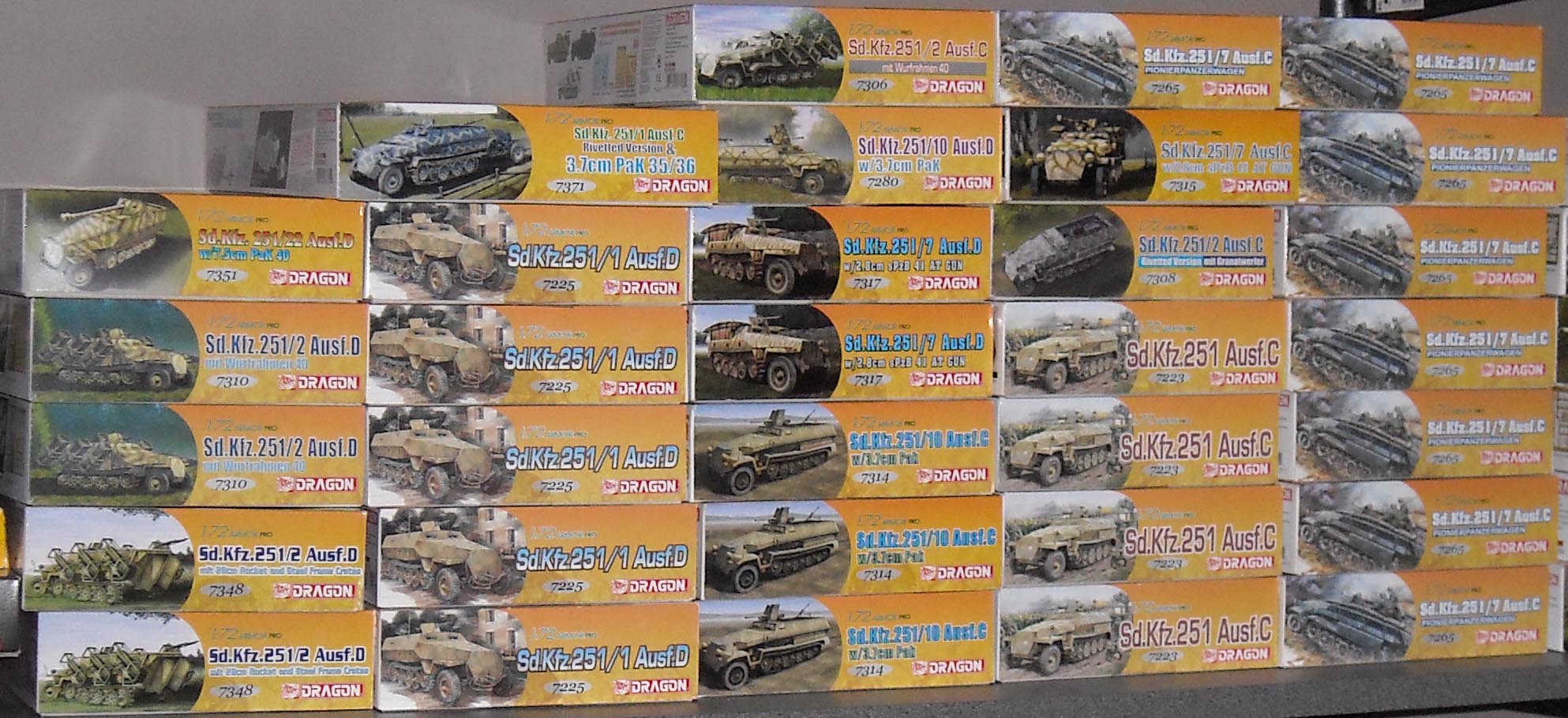
The "stash" (08 October
2009 -- it has grown since then)
While some of these kits
were already the subject of a specific preview, we will only outline
the differences between the different kits in this article. Surprisingly,
we don't have any actual construction reviews, except for
A discussion
about the dimensional accuracy of the Dragon Sd.Kfz.251 Ausf. D can
be found here.
The main differences between these
kits are (besides the boxtop and manual):
- the PE set
- the decals
- the addition of variant-specific sprues
As far as I am aware no important in-production changes were made
to the common parts as Dragon sometimes does with other kits, although
I noted that the upper hull on the Sd.Kfz.251/7 Ausf.D w/2.8cm sPzB
41 AT gun (kit 7317) has very tiny locating pegs for the bridging
equipment, so it is not impossible that some kits have other very
tiny variations. It amazes me that Dragon would actually retool its
molds just for this little detail.
First thing to notice is that any of
the kits can be built as a regular /1, because none of the unnecessary
parts have been omitted from the sprues; at least in my kits. So,
if you're after a /1, and don't mind the difference in decals and
manual, you might want to pick up, say, a /7 and have some pontoon
bridges for another project. (Sanding off the small pegs that I mentioned
earlier is really child's play.)
Well, I'm not telling the truth for 100%. You get a metal
rod in the /1 kits (and some others), for the antenna, which is
not included in (most of) the other variants, but it's not really
a big deal to make these from stretched sprue, piano wire, etc.
The addition of (a) PE set(s) is very
thoughtful; even more so as all (or almost all) the parts you get
in PE are also given in plastic (although with the limitations this
entails). Those with an alergy to brass or CA glue, or are simply
ham-fisted, are not left behind. At the same time you avoid having
to spend an extra Buck, Quid, Euro or Looney for an aftermarket set.
(Which does not mean aftermarket companies cannot enhance these kits
even further.)
That said, I am somewhat puzzled by the logic of these PE sets. For
instance the /1 Ausf. C gets PE for the MG shield, while the /1 Ausf.
C mit Wurfrahmen has to make do with styrene for its shield. On the
other hand, the latter gets PE parts for the fenders which are lacking
in the former. There are many more examples to be found.
Also, some sets include a PE licence plate for the nose. As far as
I am aware this was never fitted to the Ausf. C or D; the licence
plate number being painted directly on the armor.
The tracks
in all of these kits are of the well-known DS type and at first I
thought all the kits had exactly the same "sprue" with two
identical tracks. It took me some years to discover the following.
- Some kits contain "sprue"
251c with smooth faced track pads, which I assume represent the
Zgw 5001/280/140 Gummipolster W302 track type which is OK for most
production vehicles.
- Some kits contain "sprue"
251D1 with smooth faced track pads, which I assume represent the
Zpw 5001/280/140 Gummipolster W302 track type which is OK for most
production vehicles.
- Some kits contain "sprue"
251D2 with pads that have very subtle chevrons. The only such track
that I found in [6] is the rare all metal type ("Stahllaufketten
mit Stahlkappen"), which was only issued between February and
July 1944.
- While
both tracks are marked "D" in the instructions and "D1"
and "D2" on the rubber sprue, one (D2) is actually one
link longer than the other (D1) and should go on the right.
Note that the Ausf.D kits all come
with a Bosch headlight, while quite a number of the earlier models
of this Ausf. came with a Notek light. You should either get that
part from the spares box or from an aftermarket set.
Overview
| Kit Nr |
Decals |
PE |
Metal
Rod |
Tracks |
Sprue A |
Sprue I
chassis |
Sprue
B
|
Sprue C (2)
|
Additional
sprues |
7223
Sd.Kfz.251/1 Ausf. C
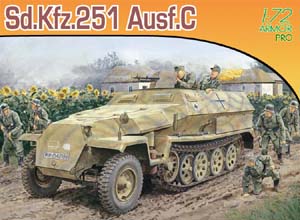 |
Generic
+ specific
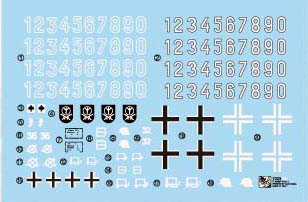 |
MG
Shield |
1 |
251D1 |
Ausf.
C |
Ausf.
C |
1 |
Ausf.
C |
|
7371
Sd.Kfz.251/1 Ausf. C Rivetted version & 3.7cm PaK 35/36

|
Generic
+ specific (labeled as from
kit 7365, which is not yet in the Dragon catalogue)
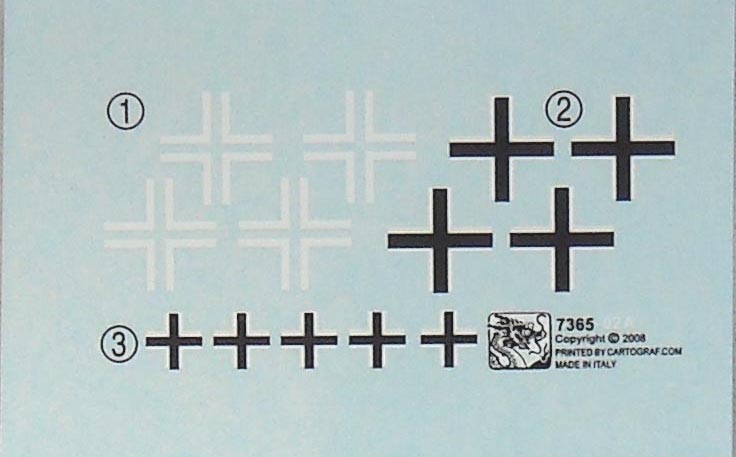
|
Rivetted
lower hull; licence plate and small fitting |
1 |
251c |
Ausf.
C with lower hull omitted (unlike in kit 7308) |
Ausf.
C |
1 |
Ausf.
C |
"Black
G": New upper hull, nose and rear plate,etc., with rivets
"Blue
G" : 2 different small sprues for PaK
(similar to those in kits 7314
and 7280, but now with a wheeled carriage instead of a roof mounting) |
7306
Sd.Kfz.251/1 Ausf. C
mit Wurfrahmen
(labeled as a /2)
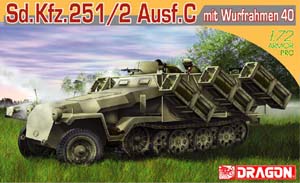
|
Slightly modified generic sheet
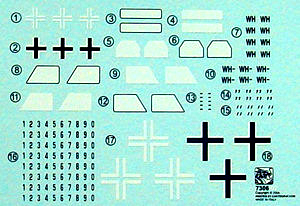
|
Fenders
and Wurfrahmen details |
0 |
251c |
Ausf.
C |
Ausf.
C |
1 |
Ausf.
C |
3 x "E":
Wurfrahmen (only with 32cm rockets) |
7308 Sd.Kfz.251/2 Ausf.
C Rivetted Version mit Granatwerfer
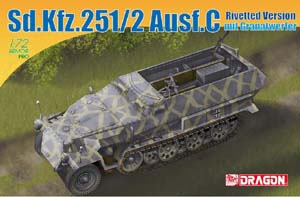
|
Generic
+ specific

|
Rivetted
lower hull and ammo bins |
1 |
251c |
Ausf.
C (slightly modified) |
Ausf.
C |
1 |
Ausf.
C |
"F":
Granatwerfer
"G": New
upper hull, nose and rear plate,etc., with rivets
(For more details see Simon Barnes' preview.)
|
7265
Sd.Kfz.251/7 Ausf. C
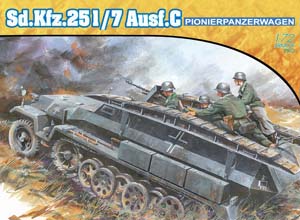
|
Generic
+ specific
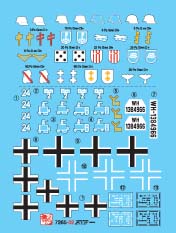
|
MG,
mudflaps, licence plate, ... |
0 |
251c |
Ausf.
C |
Ausf.
C |
1 |
Ausf.
C |
2 x "E":
Bridges |
7315
Sd.Kfz.251/7 Ausf. C with 2.8cm sPzB41
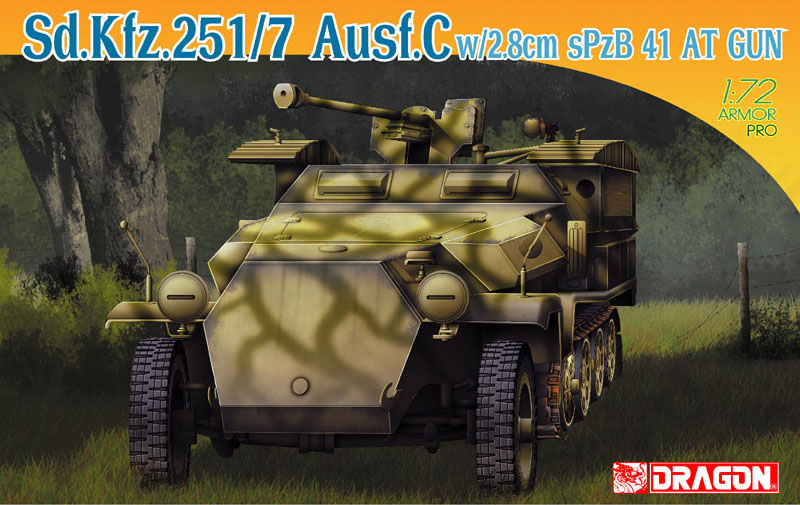
|
Generic
+ sheet from 7223
(?) |
Fenders
(same as 7314 & 7315) + gun
shield + ammo bins
(same as 7314) |
0 |
251c |
Ausf.
C |
Ausf.
C |
1 |
Slightly
modified Ausf. C |
2 x "E":
Bridges (same as 7265)
"G" :
3different small sprues for sPzB
(Interestingly
part of the carriage for the sPzB41 is given, but not the wheels
- I am not aware of a separate release of this gun) |
7314
Sd.Kfz.251/10 Ausf. C
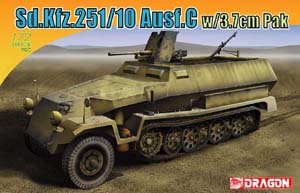
|
Generic
+ sheet from 7223
(?)
|
Fenders
(same as 7306 & 7315),
PaK shield (same as 7280),
ammo bins (same as 7315) |
0 |
251c |
Ausf.
C |
Ausf.
C |
1 |
Slightly
modified Ausf. C |
"G"
: 4 different small sprues for PaK
(similar to those in kits 7371, but with parts
for roof mounting instead of wheeled carriage) |
7225
Sd.Kfz.251/1 Ausf. D

|
Generic
+ specific
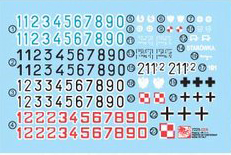 |
MG
Shield |
1 |
251D1 |
Ausf.
D |
Ausf.
D |
1 |
Ausf.
D |
|
7310
Sd.Kfz.251/1 Ausf. D
mit Wurfrahmen
(labeled as a /2)
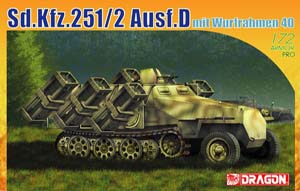
|
Generic
+ specific
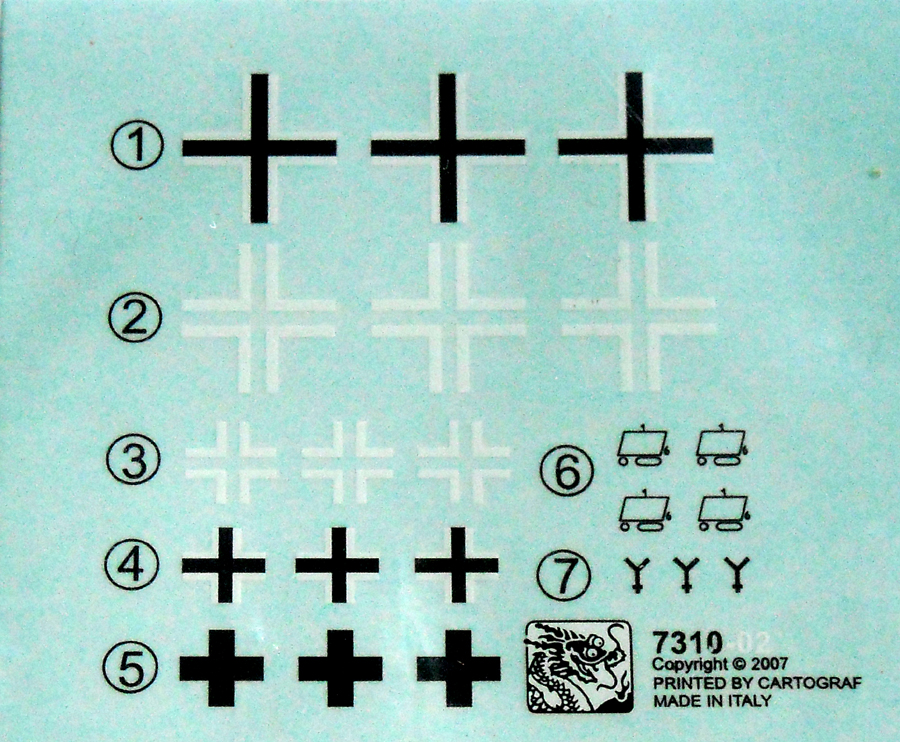
|
MG
shield and Wurfrahmen
details (same as 7306) |
0 |
251D2 |
Ausf.
D |
Ausf.
D |
1 |
Ausf.
D |
3 x "E":
Wurfrahmen (with 28cm and 32cm rockets) |
7348
Sd.Kfz.251/1 Ausf. D
mit
28cm rocket and steel frame crates
(labeled as a /2)
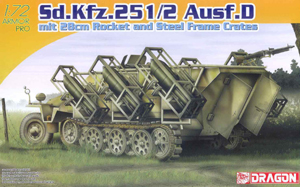
|
Generic
+ specific
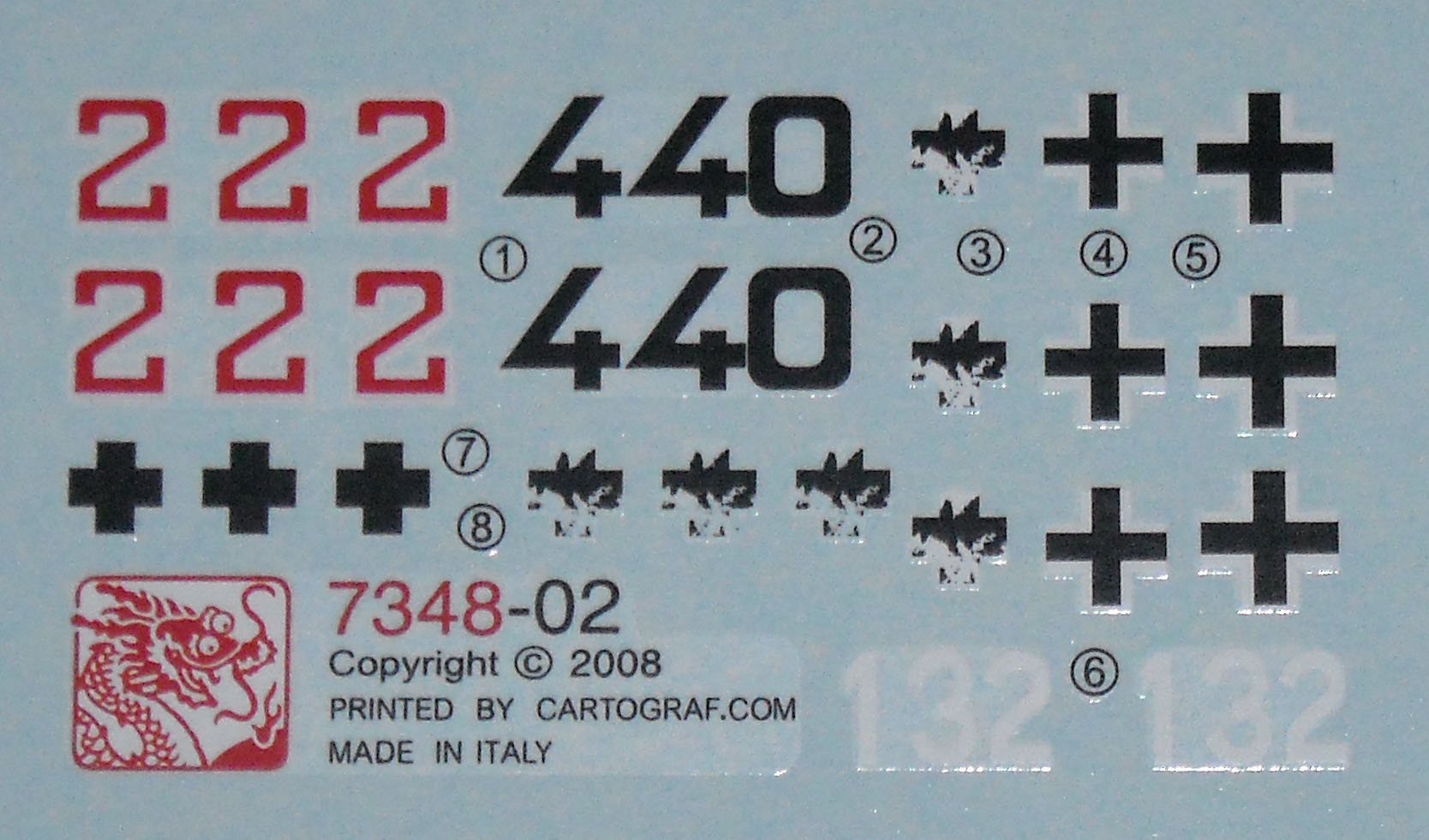
|
MG
shield, Wurfrahmen
details (same as 7306) and Wurfrahmen
frames |
0 |
251D1 |
Ausf.
D |
Ausf.
D |
1 |
Ausf.
D |
3 x "E":
Wurfrahmen (only with 28cm rockets) but no
wooden crates |
7369
Sd.Kfz.251/1 Ausf. D & 75mm PaK40
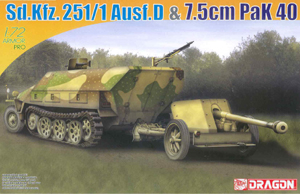
|
Slightly
modified generic sheet |
MG
shield and small PaK
part |
1 |
? |
Ausf.
D |
Ausf.
D |
1 |
Ausf.
D |
H: upper
part of PaK40
J: lower part of PaK40
|
7317
Sd.Kfz.251/7 Ausf. D with 2.8cm sPzB41
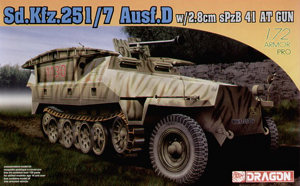
|
Generic
+ 2 specific sheets
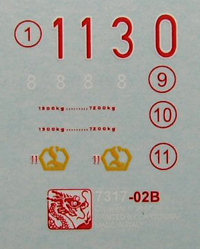
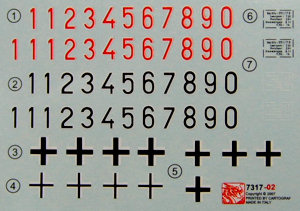
|
Brackets/licence
plates + gun shield
(same as 7315) |
0 |
251D1 |
Ausf.
D |
Ausf.
D
(Small pegs visible on the sides
of the upper hull to fix the bridges - might be present in other
/7 kits.) |
1 |
Ausf.
D |
2 x "E":
Bridges (same as 7265)
"G" : 2
different small sprues for sPzB
(one in common with 7314 and 7280 - same as 7315
minus ammo boxes- interestingly part of the carriage for the sPzB41
is given, but not the wheels - I am not aware of a separate release
of this gun) |
7280
Sd.Kfz.251/10 Ausf. D
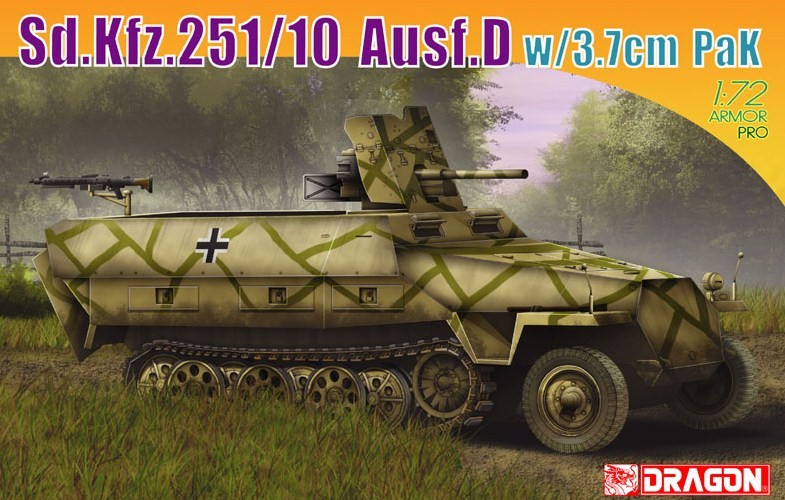 |
Slightly modified generic sheet
(same as 7306) |
Brackets/licence
plates (same as 7317), PaK
shield (same as 7314) |
0 |
251D1 |
Ausf.
D |
Ausf.
D |
1 |
Ausf.
D |
"G"
: 3 different small sprues for PaK
(as 7314 minus ammo boxes)
|
7351
Sd.Kfz.251/22 Ausf. D
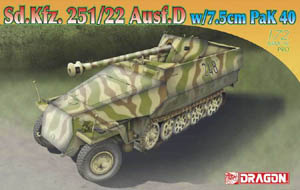 |
Generic
+ specific
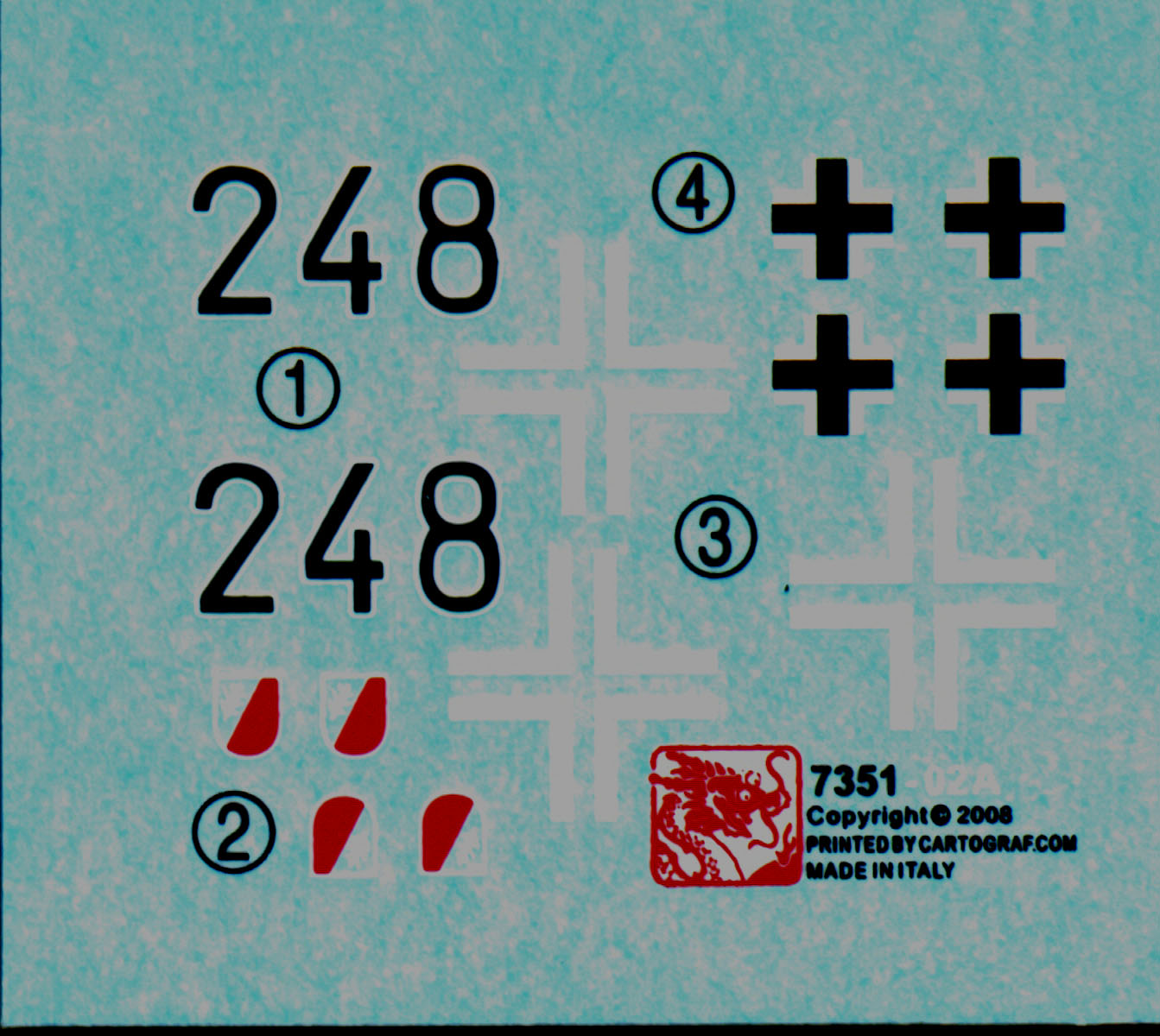 |
Gun
mount and engine hatch |
1 |
251D1 |
Ausf.
D |
Ausf.
D |
1 |
Ausf.
D |
H: upper
part of PaK40 |
A note
on the kits representing a rivetted version. I have not built these
kits yet, but the difference between welded and riveted Ausf.C hulls
is a little more subtle than just the absence/presence of rivets.
The welded hull bodies, for instance, have an overhang between the
upper half and the lower half, which the riveted hulls lack. The engine
vent hoods and rear doors are also subtly different. I haven't checked
the parts for accuracy yet, but Dragon includes new parts for these
areas, so that's already very promising.
I had
also heard warnings that some parts in the driver's area might hamper
the closure of the hull, when not placed carefully (e.g. parts A1
and A17) and can conifrm this after having built my first kit.
The instructions of some kits are incorrect when it comes to Part
B22. Some instructions show it upside down, some show it the correct
way. Parts B2 and B3 are also shown confusingly.
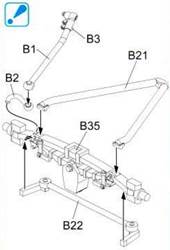
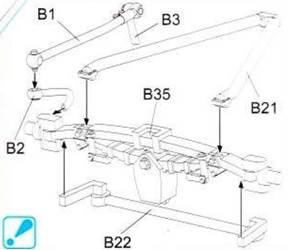
Correct installation of parts B2, B3 and B22 in some instructions
(picture on the left), confusing and wrong in others (picture
on the right), as in my kit.
(Pictures by Timothy Lau.)
I
believe that the corrected instructions are still confusing. A comparison
with the instructions from AFV Club kit 35251, might help.
_t.jpg)
(Picture
by Timothy Lau.)
A
useful picture can also be found here.
Decals and
Markings
Most kits get, what I called, a generic
sheet. This is a sheet containing licence plates and licence plate
numbers. As the numbers and prefixes are separate, the nice thing
about this system is that you can compose any specific licence plate
number you would like from Heer or Waffen-SS inits (WL prefixes for
the Luftwaffe are not included). The not-so-nice thing about this
sytem is that you HAVE to compose any licence plate number from individual
numbers, if it does not happen to be included on another sheet. Worse,
the SS runen are split in half, so you need 4 decals to form "SS".
I haven't tried these
decals yet, but as they are done by Cartograf, I have no doubt they
are of high quality.
7223 Sd.Kfz.251/1
Ausf. C

You get an admirable
seven marking options.
- Panzer Grenadier
Division Grossdeutschland, Kursk 1943. Dark yellow, green and brown.
- Infantry Division
Grossdeutschland, Eastern Front 1942. Dark gray. It seems the exact
same marking can be found on an Sd.Kfz.250 from the same unit (here
and here),
so this might be a research error. Alternatively, it might be that
an Sd.Kfz.251 replaced the Sd.Kfz.250 after these pictures were
taken.
- 4 Pz.Div., Eastern
Front, 1943. Dark yellow, with a little bit of green on the side
bins. Number 321
- Panzer Grenadier
Division Grossdeutschland, Eastern Front 1943. Dark yellow and dark
grey.
- Unknown unit, Eastern
Front, 1943. Dark yellow with a little bit of light (?) gray. (The
latter color is not identified in the color map.)
- 4 Pz.Div., Eastern
Front, 1944. Dark yellow with white splotches.
- Pz. Lehr Div.,
Hungary, 1944. Dark yellow, green and brown.
Only three of these
actually have a licence plate, so if you're lazy, choose one of the
others.
Also worthy of mention is that Dragon lets you choose some marking
options (e.g. style of numbers).
On the decal
sheet specific for this kit you get all the markings necessary
for the options on the manual and a large selection of numbers. Only
a few are needed for one of the marking options, so all the others
will spice up your spares box.
7271 Sd.Kfz.251/1
Ausf. C Rivetted
version & 3.7cm PaK 35/36
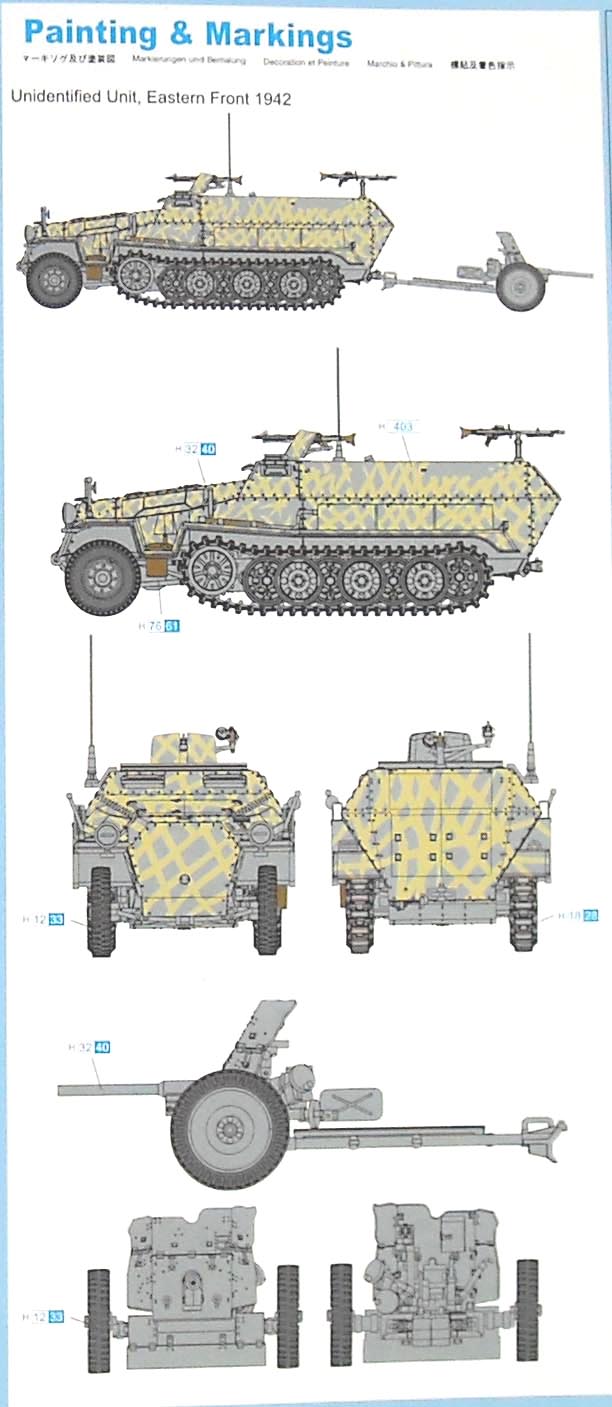
You get a miserable choice of markings,
consisting of one option, and it's a vehicle
of the ubiquitous "unknown unit", Eastern Front 1942, in
dark grey with dark yellow stripes, without any markings at all. The
Pak is uniform dark grey. The vehicle does not even carry a Balkenkreuz,
a licence plate, .... nothing !
Again, Dragon is either running out of inspiration or rushing it.
While this means you would actually not even need a decal sheet, you
get two sheets which give you some Balkenkreuze and licence plates.
Note
that the instructions of this kit allow you to build the gun in the
towed configuration, but don't tell you te remove (or, at least, fold
the bottom) of the lower shield.
7306 Sd.Kfz.251/1
Ausf. C mit Wurfrahmen 40 (labeled as /2)
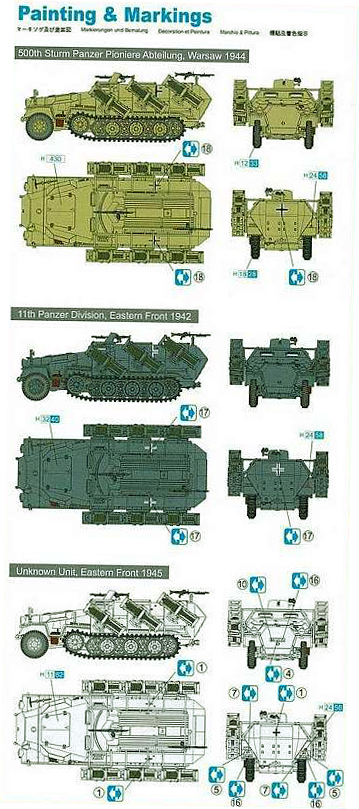
You only get three
marking options in this kit. By "only" I mean that I got
used to Dragon offering more choices in other kits, although a decade
or so we would have been delighted to have been given more than a
single marking option.
The marking options are:
- 500th Sturm
Panzer Pioniere Abteilung, Warsaw 1944. Dark yellow.
- 11 Pz.Div., Eastern Front, 1942. Dark gray.
- Unknown Unit, eastern Front, 1945. Whitewashed.
Only the last of these
three actually carry a licence plate, which has to be composed.
The markings themselves
are minimal compared to other kits: no unit insignia, only licence
plates and Balkenkreuze (in three styles).
Most of the "Stuka zu Fuss"
had aiming rods on the engine deck to help the driver align the vehicle
with the target. These are missing in the kit. Apart from that, I
guess most of the remarks made for kit 7310 will also be valid for
this one.
Note that the Wurfkörper in this kit are the 32cm type.
7308 Sd.Kfz.251/2 Ausf. C Rivetted
Version mit Granatwerfer
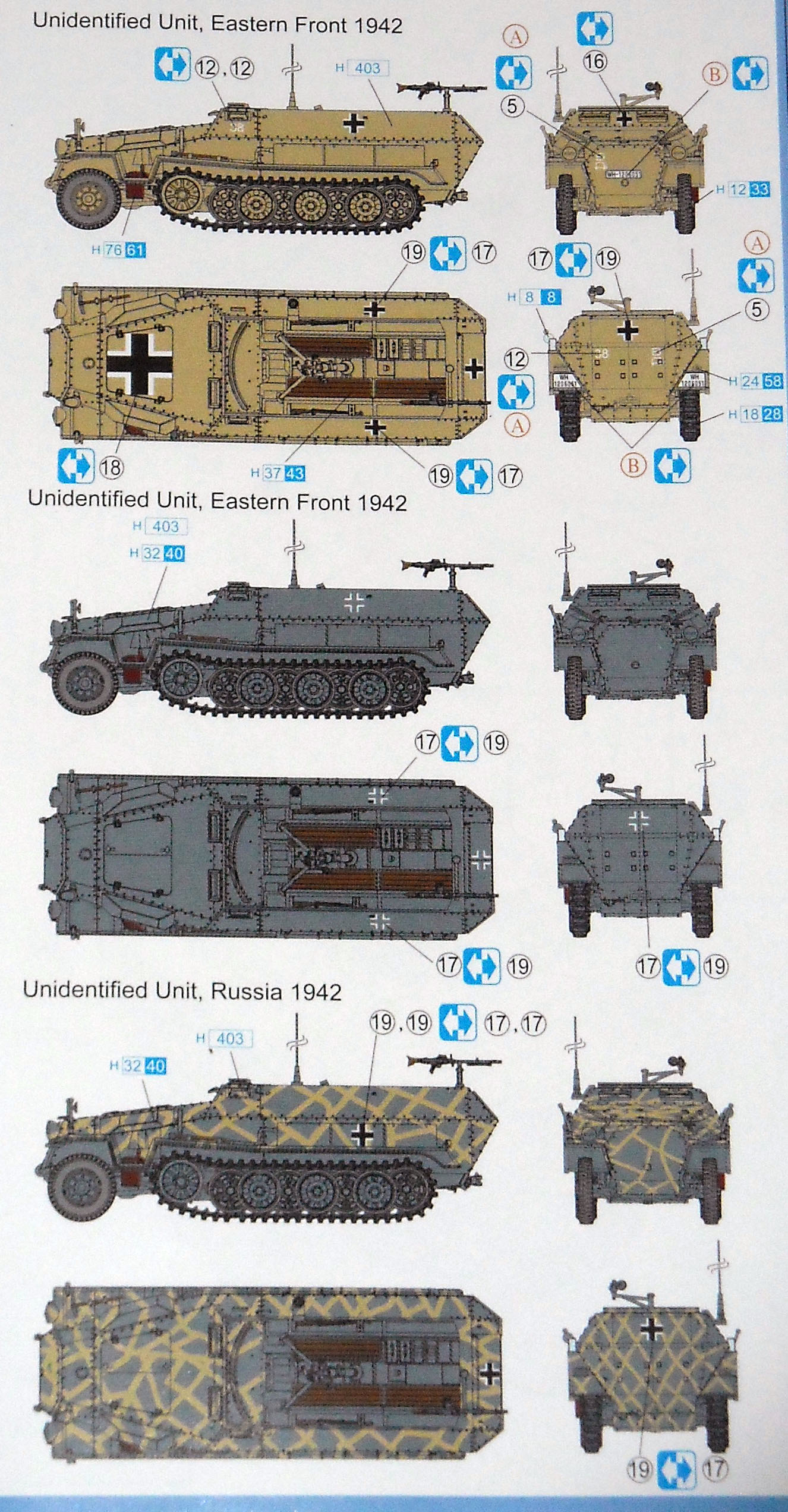
For this kit you get three marking
options, all for unidentified units:
- Unidentified unit, Eastern Front 1942. No color name is given, and
while it looks dark yellow, it will more likely be a desert color,
given the time frame. (Some vehicles destined for Afrika ended up
in Russia, and desert colors blended in well with southern sectors
of the Eastern Front.) A large Balkenkreuz is painted on the engine
hatches for aerial recognition.
- Unidentified unit, Eastern Front 1942. Overall dark grey.
- Unidentified unit, Russia 1942. Dark grey with light brown "criss-cross"
stripes. The latter areprobably a desert color, or foreign, if the
date is correct.
Only the first vehicle carries a WH-licence
plate, and this has to be manually composed.
Even though all three marking options are for unidentified units,
Dragon has been very thoughtful in providing a plethora of (spare)
unit markings (all in yellow):
- 1 Pz.Div: three different unit insignia (2 each)
- 2 Pz.Div: two different unit insignia (2 each)
- 3 Pz.Div: two different unit insignia (2 each)
- 4 Pz.Div: four different unit insignia (2 each)
- 5 Pz.Div: two different unit insignia (2 each)
- 6 Pz.Div: two different unit insignia (2 each)
- 7 Pz.Div: four different unit insignia (2 each)
- 8 Pz.Div: four different unit insignia (2 each)
- 9 Pz.Div: three different unit insignia (2 each)
- 10 Pz.Div: three different unit insignia (2 each)
- 11 Pz.Div: two different unit insignia (2 or 4 each) plus the "Gespenster"
(ghost) marking
- 12 Pz.Div: one style of unit insignia (2 each)
- 13 Pz.Div: one style of unit insignia (2 each)
- 14 Pz.Div: one style of unit insignia (2 each)
The decals above are not numbered. You also get "numbered"
decals, of which only a small part is needed for the proposed vehicles:
1-5,13,14: white tactical markings; only "5" is actually
referred to
6: White "D a".
7: White "Kursk Marking" for 3 Pz.Div.
8: Yellow 24 Pz.Div. insignia
9: Unknown insignia (black and white)
10: Yellow 22 Pz.Div. insignia
11: Unknown insignia (white)
12: White "38", used on the first marking option
15: White Grossdeutschland "Stahlhelm" insignia
16-19: Balkenkreuze
Thanks
to info obtained from Timothy Lau, it is highly likely that
- decals
3, 6, 8 and 17 (a style of the Balkenkreuz which seems particular
to 24. Pz.Div.) are taken from a 251/6, seen here.
- decals
5, 12, 18, and 19 are for a 21. Pz.Div. Sd.Kfz. 251/1 that was not
riveted.
Given the fact that this kit can be
built as a welded or a rivetted version, as a /2 or a /1 and the vast
amount of spare decals, this is one of my favorite kits in the series
(together with the /7). If you build it as a welded /2, you can use
the spare parts to convert any other Ausf.C to a rivetted hull.
Most of the mortar carriers had aiming
rods on the engine deck to help the driver align the vehicle with
the target. These are missing in the kit.
7265 Sd.Kfz.251/7
Ausf. C
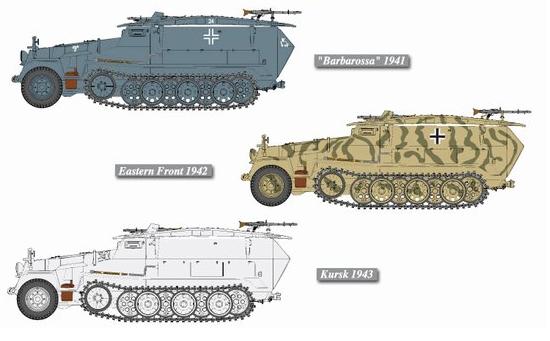
You again only get
three marking options. They are:
- Dark gray vehicle "Barbarossa 1941"
- Whitewashed vehicle "Eastern Front 1942"
- Dark Yellow and green vehicle "Kursk 1943"
Only the first of these
three actually carries a licence plate. What is actually more disappointing
is that Dragon does not give the unit these vehicles belong to. Also
worthy of mention is that Dragon lets you choose within a marking
option between styles of crosses, colors of markings etc.
The decal
sheet which is specific for this kit has a lower part containing
the decals to be used for the three marking options in the manual
(see above) and an upper part with a collection of unit markings that
are spares. This is very thoughtful of Dragon, as you can use them
on any vehicle you would like if you are not using them on this one.
On offer are
- "Grossdeutschland ("steel helmets")
- 3.Pz.Gren.Div.
- 10.Pz.Gren.Div.
- 16.Pz.Gren.Div.
- 18.Pz.Gren.Div.
- 19.Pz.Gren.Div.
- 20.Pz.Gren.Div.
- 22.Pz.Gren.Div.
- 25.Pz.Gren.Div.
- 29 Pz.Gren.Div.
- 60.Pz.Gren.Div.
- 90.Pz.Gren.Div.
(Actually, the lower part of the sheet also contains some spares.)
Note that the licence plate for the first marking option is pre-assembled.
Decal-wise this is
clearly one of the best kits (together with 7308). Not only do you
get lots of spares, but if you keep to the proposed markings you do
not need to fiddle with composing licence plates, although you can
if you'd want.
7315 Sd.Kfz.251/7
Ausf. C with 2.8cm sPzB 41
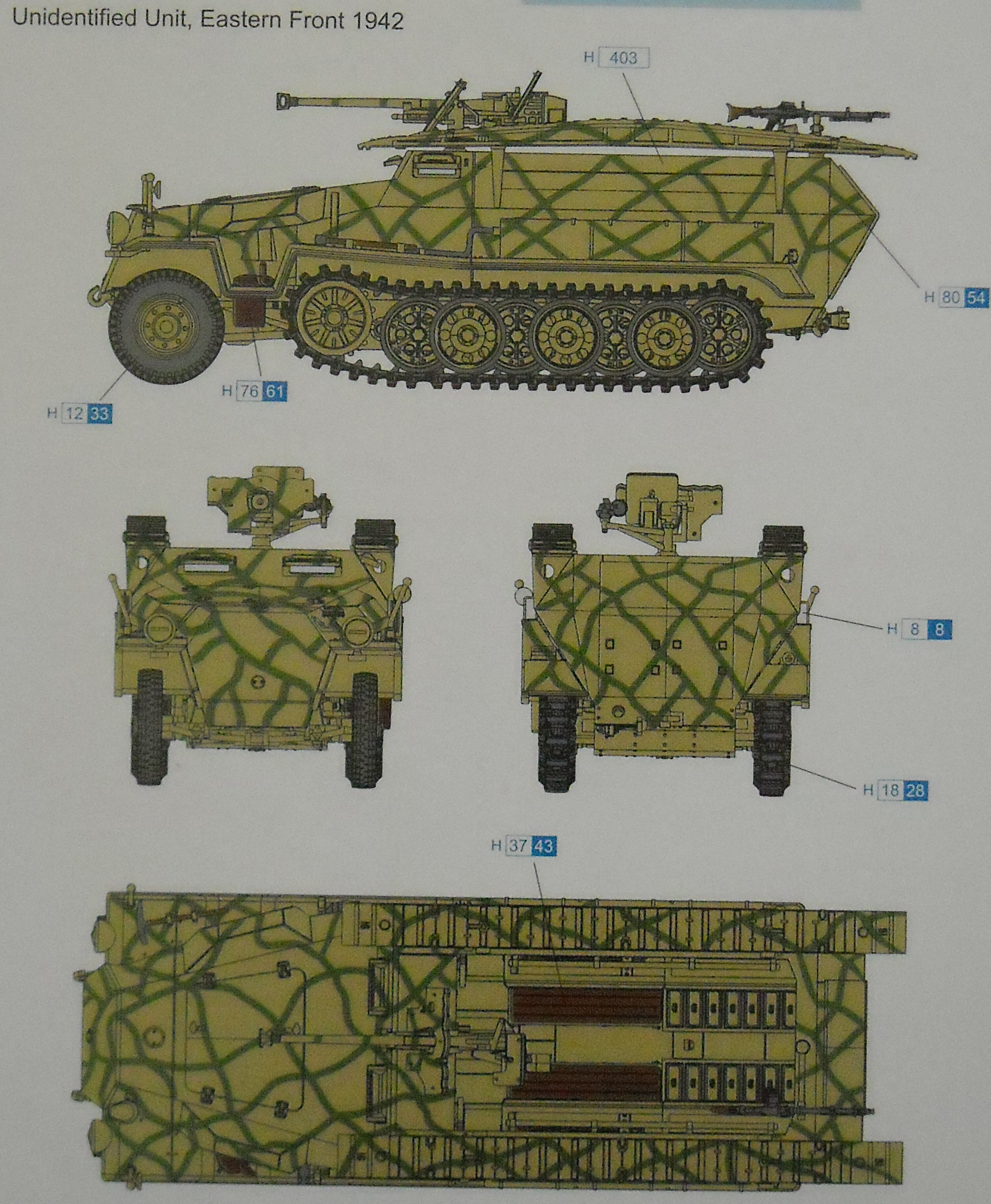
This is a very disappointing
kit when it comes to markings. You only get one option, and it's a
vehicle of an unknown unit, in dark yellow with green stripes, without
any markings at all !!!
Not even Balkenkreuze, a licence plate, .... nothing !
Dragon must have run out of inspiration, when you compare this with
their Sd.Kfz. 251/2 Ausf. C, Sd.Kfz. 251/7 Ausf. C or Sd.Kfz. 251/1
Ausf. D ! One reason might be that this vehicle is undocumented and
thus might not have existed (cf. discussion about kit 7317).
This means you would
actually not even need a decal sheet. Still, you get two sheets: the
generic sheet and the exact same sheet as that
included in the Sd.Kfz.251/1 Ausf.C. (The kit number wasn't even
changed on it.)
The good thing is that
this kit can be built as a regular /1 or /7, which would leave you
with a nice Panzerbüchse for which you would only need a donor
Lafette.
Note that the PE parts
allow you to create the "double armor" shields so familiar
on German guns.
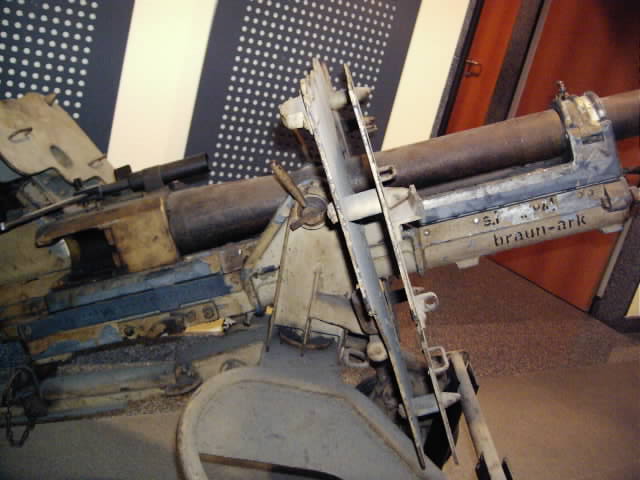
Picture taken by myself at the office
7314 Sd.Kfz.251/10
Ausf. C
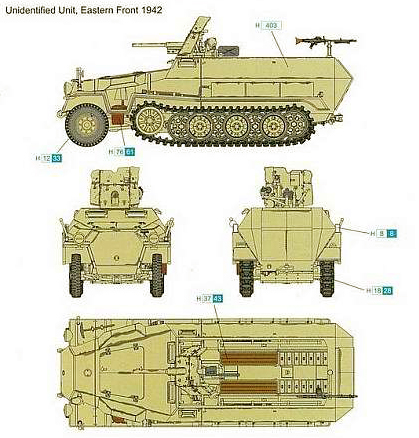
This is a very disappointing
kit when it comes to markings. You only get one option, and it's a
plain dark yellow vehicle of an unknown unit without any markings
at all !!!
Not even Balkenkreuze, a licence plate, .... nothing !
Dragon must have run out of inspiration, when you compare this with
their Sd.Kfz. 251/2 Ausf. C, Sd.Kfz. 251/7 Ausf. C or Sd.Kfz. 251/1
Ausf. D !
This means you would
actually not even need a decal sheet. Still, you get two sheets: the
generic sheet and the exact same sheet as that
included in the Sd.Kfz.251/1 Ausf.C. (The kit number wasn't even
changed on it.)
If these lines sound
familiar, they sadly are.
So, if you are not
really after the /10, this is one to pass by. If you do want a /10
keep in mind that the PaK-shield is a very nice PE
part, but you do not get a styrene equivalent. If you want a low
cut shield, you are in for some scratchbuilding.
7225 Sd.Kfz.251/1
Ausf. D
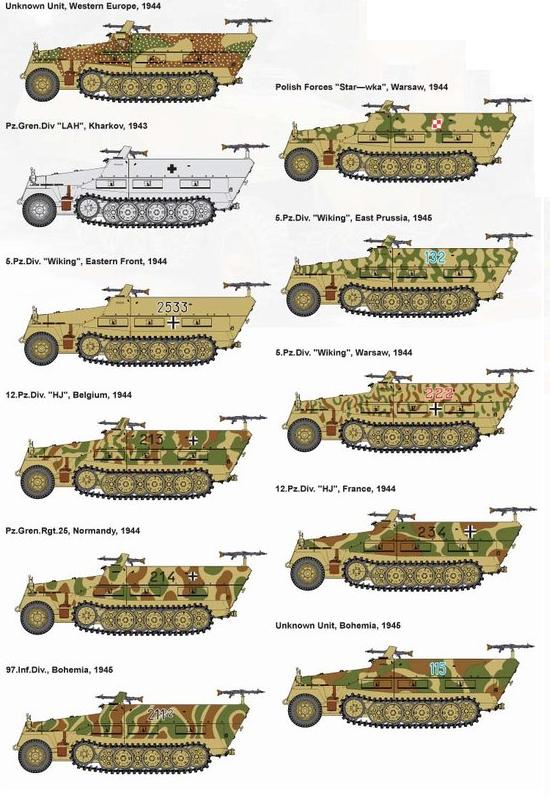
You get a whopping
11 marking options !
- Unknown Unit, Western
Europe, 1944. "Ambush" (Licht und Schatten) scheme.
- Polish Forces "Starowka",
Warsaw, 1944. Dark yellow and green. Note that all pictures we have seen of this vehicle show it without front fenders; something the instructions don't point out.
- Pz.Gren.Div. "LSSAH"
(Dragon calls it "LAH" for "technical" reasons),
Kharkow, 1943. Whitewashed. This marking option is spurious as there
was no Ausf. D at Kharkov. (The first Ausf.D were only produced
in May 1943, while the 1943 battle of Kharkov took place in February
1943.)
- 5. SS Pz.Div. "Wiking"
(Dragon calls it 5.Pz.Div. for "technical" reasons), East
Prussia, 1945. Dark yellow and green. Number "132".
- 5. SS Pz.Div. "Wiking"
(idem), Eastern Front, 1944. Dark yellow. Number "2533".
- 5. SS Pz.Div. "Wiking"
(idem), Warsaw, 1944. Dark yellow, green and brown. Number "222".
- 12. SS Pz.Div.
"HJ" (Dragon calls it 12.Pz.Div. for "technical"
reasons), Belgium, 1944. Dark yellow, brown and green. Number "213".
- 12. SS Pz.Div.
"HJ" (idem), France, 1944, Dark yellow, brown and green.
Number "234".
- Pz.Gren.Rgt. 25,
Normandy, 1944. Dark yellow, brown and green. Number "214"
I am not 100% sure about this one, but it will more likely be the
SS Pz.Gren.Rgt. 25 (part of 12 SS.Pz.Div. "HJ"), which
was present in that theatre of operations, while Pz.Gren.Rgt. 25
(part of 12 Pz.Div.) was on the Eastern front in 1944.
- Unknown Unit, Bohemia,
1945. Dark yellow, brown and green. Number "115" .
- 97 Inf.Div., Bohemia,
1945. Dark yellow, brown and green. Number "211 over 322".
This is based on dubious research about this
vehicle. There's a picture of the vehicle from the other side
which shows, quite clearly, that the vehicle marking was not symmetric
on both sides.
Only two of these actually
have a licence plate (which needs to be assembled), but
- "Starowka"'s licence plate doesn't have a number in the
manual.
- The other vehile with a licence plate is number 132 from 5 SS Pz.Div.
Again, for "technical" reasons, the licence plate is a "WH"
one. While it is quite obvious these need to be "SS", I
have no idea about the number though.
It is very strange
that Dragon only chooses one non-SS unit (apart from the "unidentified"
ones), while it is so sensitive about political correctness. Plenty
of Heer units used this vehicle, so why not use those ? It is even
stranger that 6 vehicles come from only 2 divisions.
It follows that at least one licence plate cannot be correct while
the standard "sunwheel" marking of 5 SS Pz.Div is not depicted
in a single one of them. It could be that variations existed, but
the alternative explanation might be that Dragon modified them to
avoid representing something looking like a swastika.
Also worthy of mention is that Dragon lets you choose within some
of the marking options between styles of crosses, colors of markings
etc.
On the decal sheet which is
specific for this kit you get all the markings necessary for the
options on the manual and a large selection of numbers in 3 color/style
combinations. Only a few are needed, so all the others will spice
up your spares box.
Timothy
Lau points out that the ambush pattern of the first marking option
is remarkably close to that of this
vehicle, which is an Sd.Kfz.251/2.
That camouflage pattern is probably unique to this vehicle (as this
was definitely not a standard scheme for halftracks).
7310 Sd.Kfz.251/1
Ausf. D mit Wurfrahmen 40 (labeled as /2 by Dragon)
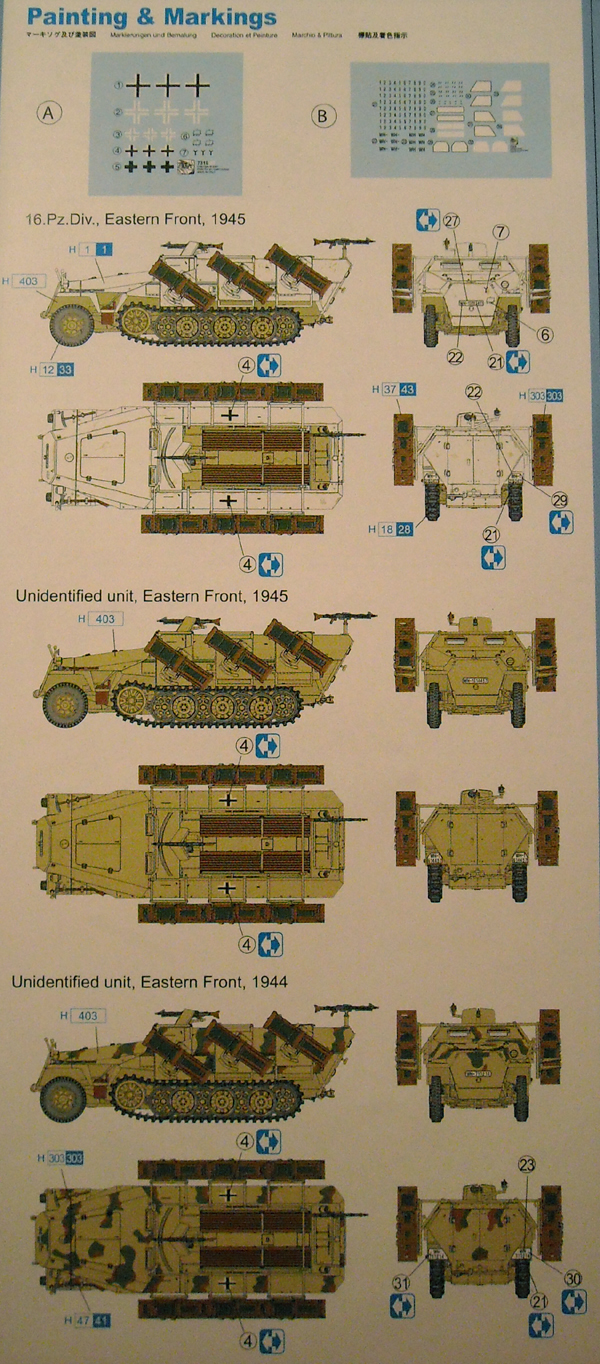
You only get three
marking options:
- 16. Pz.Div.,
Eastern Front, 1945. Whitewashed
- Unidentified unit, Eastern Front, 1945. Dark yellow.
- Unidentified unit, Eastern Front, 1944. Dark yellow with green and
brown.
The markings on the
decal sheets are minimal compared to other kits: mainly Balkenkreuze
plus some tactical markings, but no unit insignia. All vehicles carry
licence plates which need to be composed.
Timothy
Lau adds the following comments about the markings:
The
first scheme provides a whitewashed 16 Pz.Div. vehicle. The only
picture I can find of a 16. Pz.Div. 251 with the Stuka zu Fuss is
the second vehicle in this
column.
From what I can tell, the vehicle is actually an Ausf. C. That does
not exclude the possibility of an Ausf. D "Stuka zu Fuss,"
but it isn't good.
Anyway, the bigger problem is the Balkenkreuz. Here is a picture
of a 251/3
belonging to 16 Pz.Div. It's a low-viz Balkenkreuz, with nothing
other than the black frame, which is not provided within the decals
of the kit. A recent picture of a 251/9 popped up on the eBay
thread on Missing-Lynx that confirms my suspicion that the vehicles
of 16. Pz.Div. had low-viz Balkenkreuze on top of their whitewash.
The Balkenkreuz style seen on the eBay picture is exactly the same
as the 251/3, which strongly suggests to me that it is a 16. Pz.Div.
vehicle. Anyway, you can see that the 251/9 actually has two Balkenkreuze:
one whitewashed over and the other, low-viz one on top of the Balkenkreuz.
Note also this
picture of a 251/7 belonging to 16. Pz.Div (seen in the top-middle
image, in the background). Certainly the 251/7 does not have a high-viz
Balkenkreuz.
What
does that mean? The decal sheet provided is almost certainly flawed.
If the builder wants to use the 16. Pz.Div. markings on the sheet
and make a whitewashed vehicle, he/she should find a low-viz Balkenkreuz.
He/she should probably also use a Ausf. C kit.
Most of the "Stuka zu Fuss"
had aiming rods on the engine deck to help the driver align the vehicle
with the target. These are missing in the kit.
The missile bodies are nicely done,
but cleaning up the casting seem is going to prove a real pain. Also,
to be 100% correct, you need to drill out the tiny jet nozzles on
the base of the rocket. See references [1-4] for pictures. Good luck
! (Perhaps we will get a PE part for that one day.)
When assembling the wooden launcher crates, take good care to distinguish
both parts as they look very similar, but aren't. Note that the "cross-beams"
on top and bottom (purpose unknown) are all parallel, while pictures
show them in an oblique configuration. Apparently these were loosened
by the launching process, so it might be they are meant to secure
the rockets in the crates, but that's only a guess. Beware that the
rockets cannot be slid into the crates after assembly of the latter
!
The way the kit is engineered you can only choose a single elevation
for the rocket launchers, while in reality these varied from 16°
to 45°. To that effect, part MB2 is the locking handle to fix
the elevation and the quadrant (part MB3) lets you read the elevation.
This is the reason why both parts are fixed with respect to the vehicle,
while part MB1 rotates. Something to keep in mind if you decide to
modify the elevation angle.
7348 Sd.Kfz.251/1
Ausf. D mit
28cm rocket and steel frame crates (labeled
as /2 by Dragon)

You get four marking
options:
- Pz.Gren.Rgt. 'LAH',
Pz.Gren.Div. 'LAH', Kharkov, 1943 (Actually an SS unit, but not
mentioned as such).
Again the Ausf. D was not yet operational at the time of the battle.
- 12 Pz.Div. 'HJ',
France, 1944. Vehicle '440'. Dark yellow and green. (Actually 12
SS Pz.Div.)
- 5 Pz.Div. 'Wiking',
Warsaw, 1944. Vehicle '222'. Dark yellow, green and brown. (Actually
5 SS Pz.Div.). A sister vehicle of this
one, and likely not to have rockets. Incidentally same unit
and marking as one in kit 7225 (thus without rockets.)
- Pz.Gren.Rgt. 13,
5 Pz.Div., East Prussia, 1945. vehicle '132'. Dark yellow and green.
For the first marking option Dragon
lets you choose between three styles of Balkenkreuze: solid black,
solid black with white overspray, or solid black with "see through
patches". The latter will give the same effect, but probably
in a more realistic way than the second.
You get no unit insignia on the sheet.
According to the marking instructions, none of these vehicles carries
licence plates, so the generic sheet is redundant.
Strangely enough, the marking options
clearly show the fourth vehicle with a blue and white '132', but my
decals for these markings only have white.
7369
Sd.Kfz.251/1 Ausf. D & 75mm PaK40
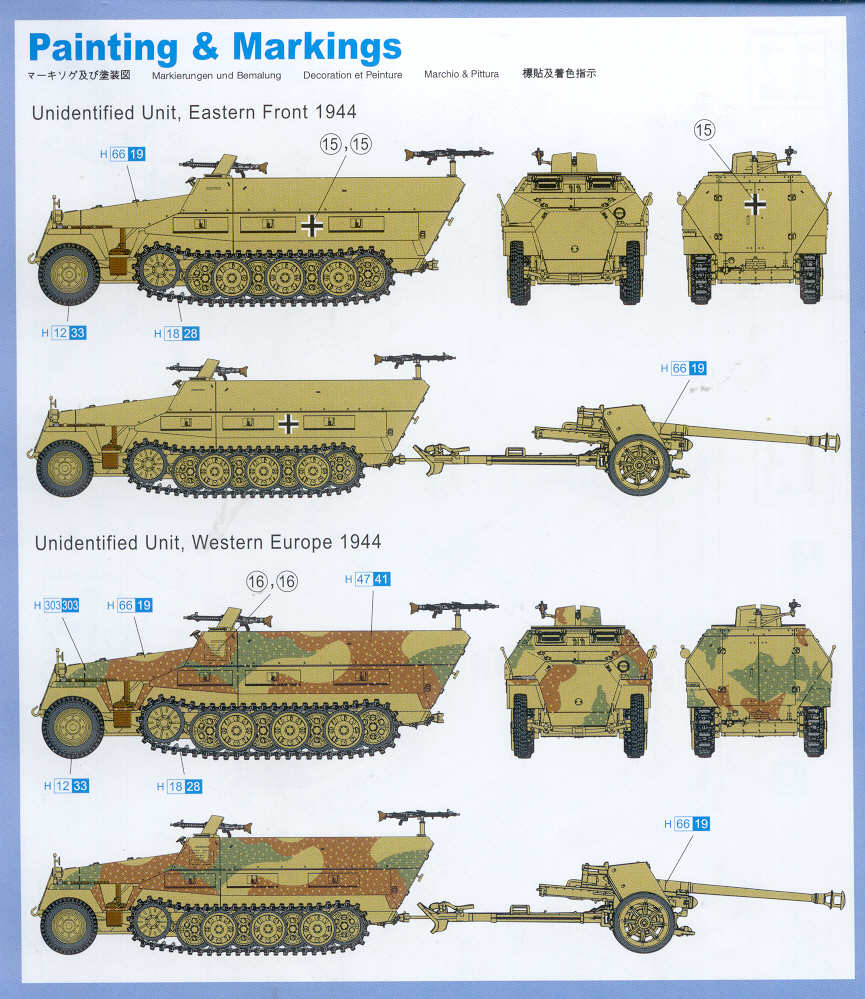
You only get two marking
options:
- Unidentified
unit, Eastern Front, 1944. Dark yellow.
- Unidentified unit, Western Front, 1944. Licht und Schatten scheme
(aka 'Ambush scheme').
The markings on the decal sheets are
minimal compared to other kits: no insignia, only 3 Balkenkreuze and
the licence plates on a slightly modified generic sheet, which now
includes a vehicle data stencil.
Note that the regular towing variant
for the Pak40 was the Sd.Kfz.251/4, although the /1 was also used
sometimes.
Timothy
Lau points out that the ambush pattern of the second marking option
is remarkably close to that of this
vehicle, which is an Sd.Kfz.251/2.
That camouflage pattern is probably unique to this vehicle (as this
was definitely not a standard scheme for halftracks).
As the
Pak is the same as in kit 7374,
Al Magnus' review of the latter might be useful.
7317 Sd.Kfz.251/7
Ausf. D with 2.8cm sPzB 41
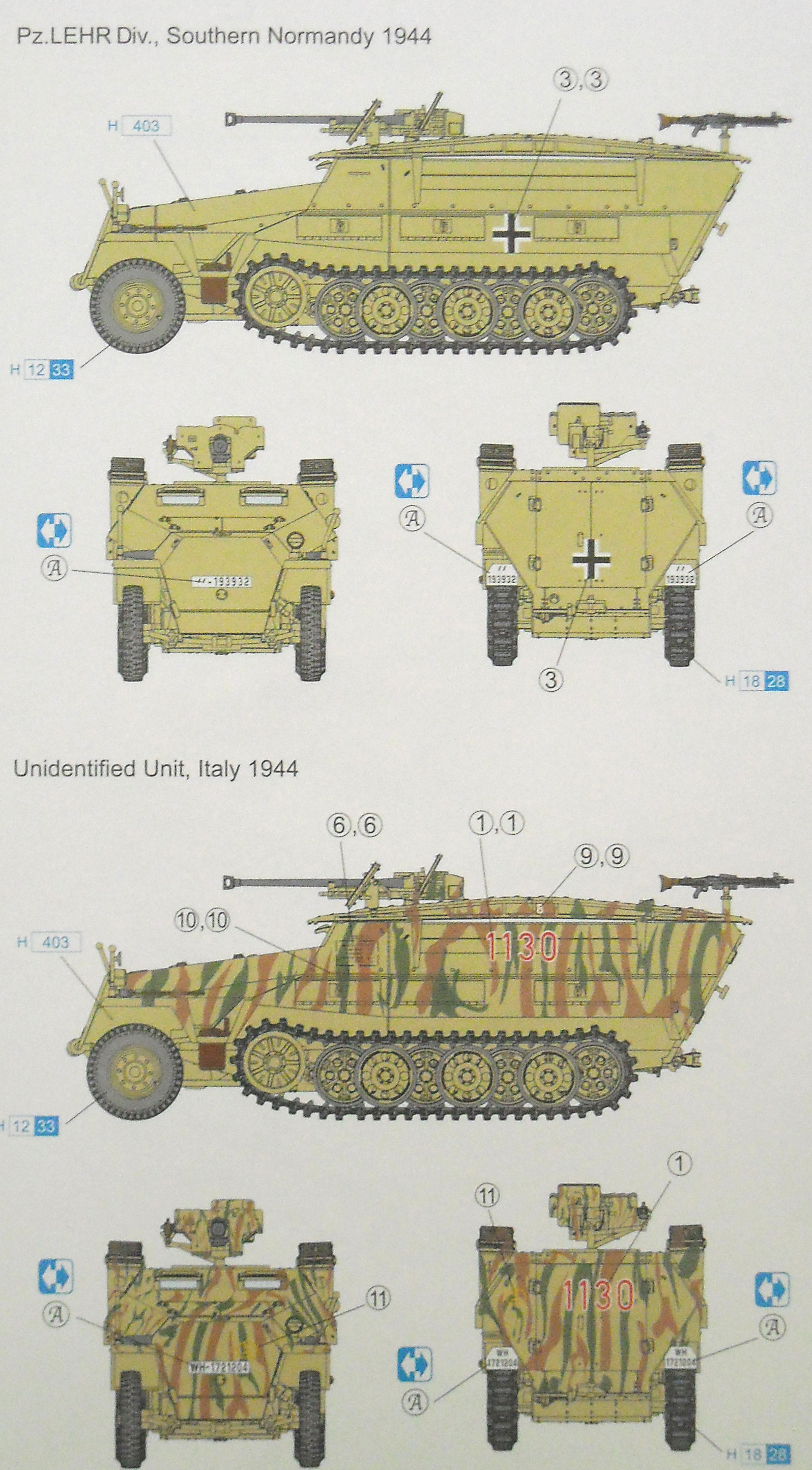
You only get two marking
options:
- Pz. Lehr. Div, Southern Normandy 1944. Plain dark yellow.
- Unidentified Unit, Italy 1944. Dark yellow with green and brown
stripes.
In my humble opinion
Dragon messed things up here. If the first vehicle is really from
Pz. Lehr, than why would it need SS licence plates? Secondly, why
would the second vehicle have a big caligraphic "L" on the
front and rear? Apart from that, not too many Waffen SS units were
active on the Italian front, so the other option might at first glance
be a bit iffy as well.
The good thing is that
this kit can be built as a regular /1 or /7, which would leave you
with a nice Panzerbüchse for which you would only need a donor
Lafette. This is all the better, as this variant of the Sd.Kfz.251
probably didn't even exist. (See here
for a discussion.)
Note that the PE parts
allow you to create the "double armor" shields so familiar
on German guns.
For some reason the
interior is left unaltered, so you get no ammo bins, as for kit 7315.
I don't know whether this is accurate (assuming the vehicle did exist),
but I guess the crew had to store the same ammo as used on the Ausf.
C.
7280 Sd.Kfz.251/10
Ausf. D
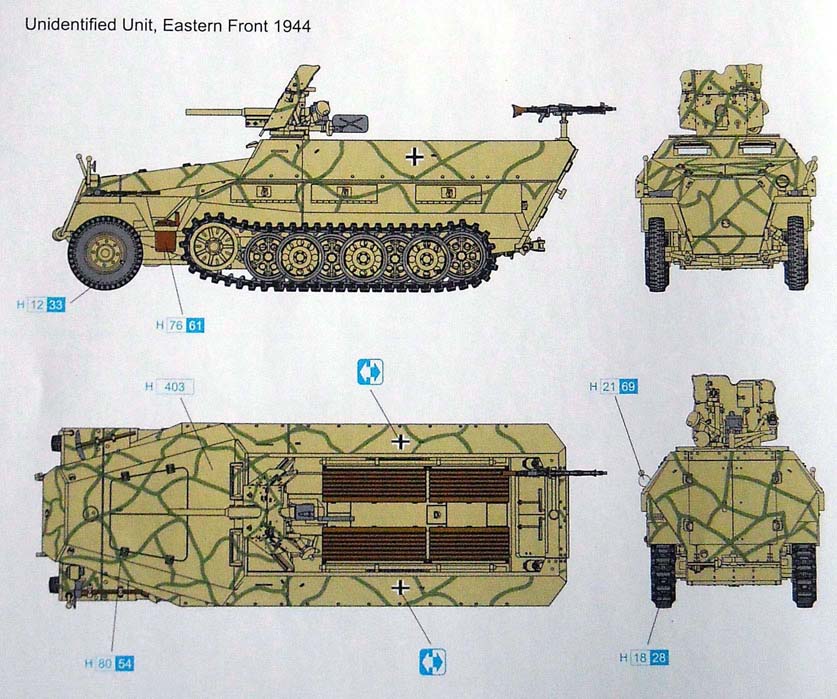
Decal-wise, this is
again a very disappointing kit, only offering a single marking option
for the ubiquitous "unidentified unit on the Eastern Front"
in 1944; camouflage is Dark Yellow + Green.
The decals are basically the generic sheet with 9 Balkenkreuze (3
styles) added and are identical to those in kit 7306. On Dragon's
website I found a review mentioning two decal sheets, but in my specimen
this was not the case; only one sheet is mentioned in the manual as
well.
Apart from that, you
could have expected this kit to be a cross-over between the Sd.Kfz.251/10
Ausf. C and Sd.Kfz.251/1 Ausf. D kits. It basically is, but for some
reason the interior is left unaltered, so you get no ammo bins, as
for the Sd.Kfz.251/10 Ausf. C kit (contrary to what the review on
Dragon's website tells us). I don't know whether this is accurate,
but I guess the crew had to store the ammo somewhere, so I have my
doubts.
Personally, if I wanted to model this variant, I would play it safe
and go for a kit-bash between the Sd.Kfz.251/10 Ausf. C and Sd.Kfz.251/1
Ausf. D, which would also leave you with a perfectly acceptable Sd.Kfz.251/1
Ausf. C.
As Jolyon Ralph pointed
out to us, it is questionable if the Sd.Kfz. 251/10 Ausf.D was ever
fitted with the full height gun shield. Modifying the PE part will
be very hard to pull off though.
7351 Sd.Kfz.251/22
Ausf. D
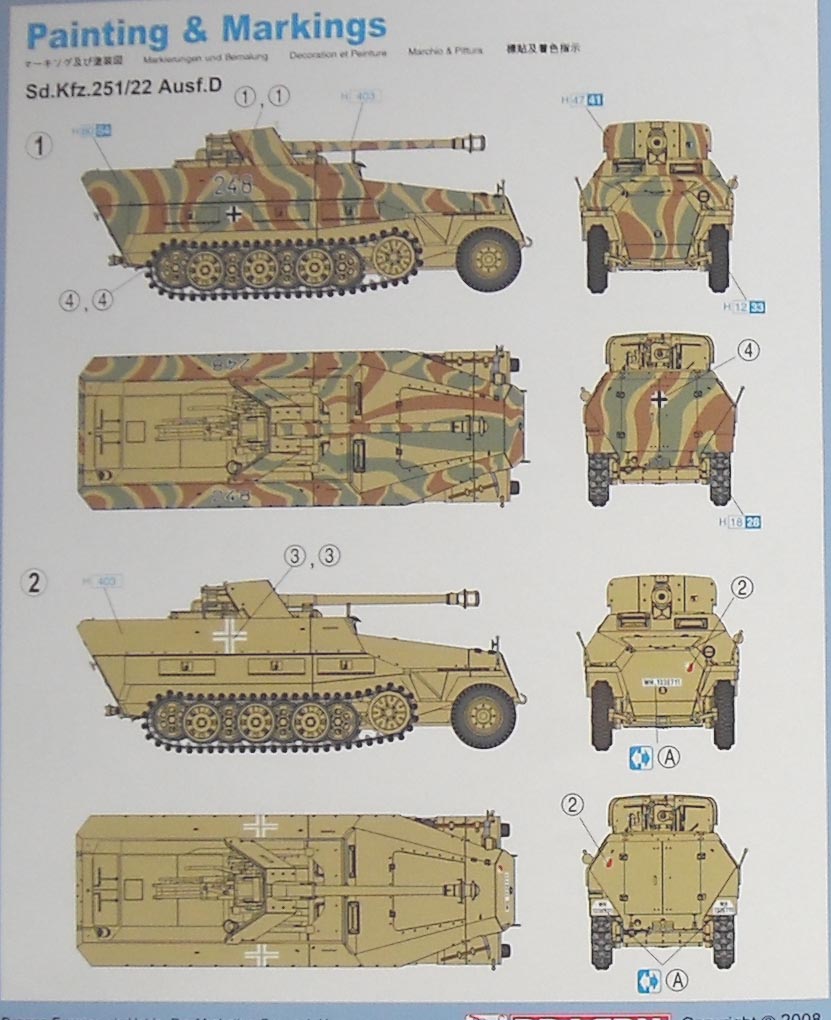
This time you get to
choose between two vehicles:
- black 248 in three color camo with black and white Balkenkreuze
and no licence plates
- a plain dark yellow vehicle with larger, white Balkenkreuze and
licence plates. It carries, what seems to be, a unit insignia.
Sadly enough, Dragon
does not indicate which units these vehicles belonged to, what front
they operated on, or at what time, even though the second vehicle
seems to carry a unit insignia, which I have been unable to identify.
You get that decal four times, while you only need it twice (according
to the instructions).
Dragon knows that late
war vehicles had a different, rear-hinged engine hatch, but clearly
doesn't know what it looked like. Either that, or they were unwilling
to alter the upper hull part. What they did is give you a new PE part
for the hatch, but they kept the original dimensions of the engine
compartment hatch. In reality that hatch extended more to the front
and there was a secondary laterally hinged hatch in front of it. So,
you couldn't just get away scribing that secondary hatch as you would
need to enlarge the main hatch as well. At that point you are ready
to throw away the PE part, so what was Dragon's point to start with
?
I should check my reference thoroughly, but it also seems that most
of these late war vehicles had the left (driver's) visor replaced
with a simpler, flatter type and the right frontal visor either blanked
off or replaced with the same flat type. (That would be fairly easy
to scratchbuild, though.)
According to my references, some
/22s were built on the older Ausf.D chassis (e.g. one that was field
modified and shown in Panzerwrecks 2 & 6). By"older"
I mean, with the split hatch, so you might get away by simply getting
rid of the PE engine hatch and using the older, split doors which
come in styrene as in all other Ausf. D kits.
(By comparison, Hasegawa provides flat visors in their /22 kit, but
leaves the engine deck unaltered.)
My references also tell me that the radio set was moved away from
the right front side (where the R/O used to be, but which space was
now inaccessible - hence the blanked off plate). Dragon doesn't. However,
specialists in the field are still arguing where exactly the set was
moved to...
A nice thing is that you get the choice of three types of gun barrel
for the Pak40.
Below is a rough sketch to illustrate
the issue with the engine deck.
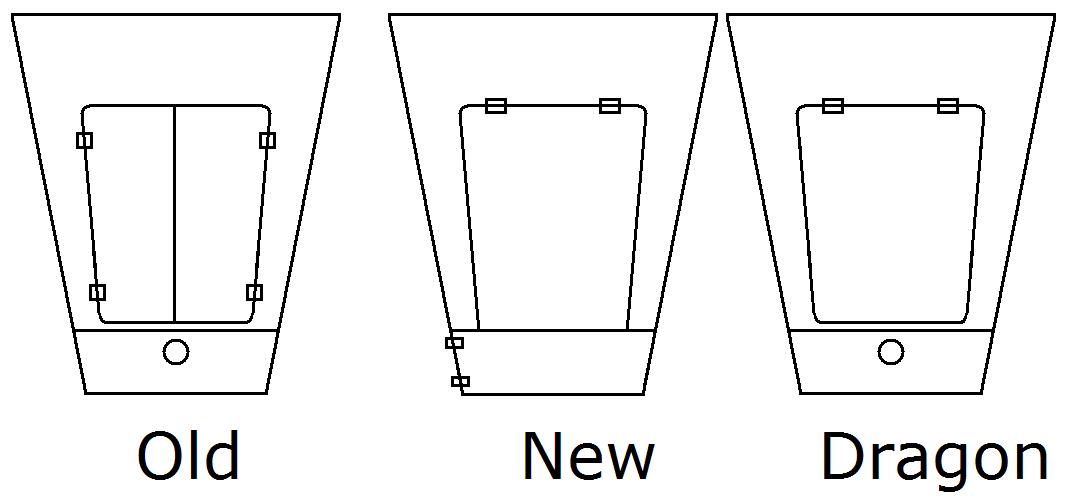
References
[1] http://www.germanmilitaria.co.uk/ammu.htm#mm320artil
(defunct)
[2] http://upload.wikimedia.org/wikipedia/commons/5/5b/Bundesarchiv_Bild_101I-216-0417-05,_Russland,_schwerer_Wurfrahmen_an_Sch%C3%BCtzenpanzer.jpg
[3] http://en.wikipedia.org/wiki/Wurfrahmen_40
[4] http://commons.wikimedia.org/wiki/Category:Wurfrahmen_40
[5] Panzer
Tracts 15-2 Mittlere Schuetzenpanzerwagen (Sd.Kfz.251), T.L. Jentz
& H.L. Doyle
[6] Panzer
Tracts 15-3 Mittlere Schuetzenpanzerwagen (Sd.Kfz.251) Ausf.C &
D, T.L. Jentz & H.L. Doyle
[7] Kanonenwagen
Sd.Kfz.251/9 "Stummel", Nuts & Bolts 21, H.F. Duske,
T. Greenland, D. Terlisten
Dragon
kits can be purchased from

|